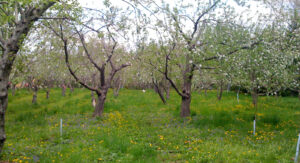Alternative Pollinators: Native Bees
By Eric Mader, Mace Vaughan, Matthew Shepherd, and Scott Hoffman Black
The Xerces Society for Invertebrate Conservation
Abstract

Mason bee on Berberis. Photo: Jack Dykinga, USDA-ARS
This publication provides information and resources on how to plan for, protect and create habitat for native bees in agricultural settings. Creating and preserving native bee habitat is a good risk management strategy for farmers of specialty crops such as almonds, apples, blackberries, blueberries, cherries, cranberries, pears, plums, squash, tomatoes and watermelons. Oil and biofuel crops requiring bee pollination include canola and sunflower. Even meat and dairy industries are dependent on bee pollination for the production of forage seed such as alfalfa and clover. In many cases, these native pollinators are, on a bee-for-bee basis, more efficient than honey bees.
Introduction

Mining bee carrying load of yellow pollen entering nest. Photo: Matthew Shepherd, The Xerces Society
Worldwide, there are an estimated 20,000 species of bees (Michener, 2000), with approximately 4,000 species native to the United States (Winfree et. al., 2007). The non-native European honey bee (Apis mellifera) is the most important crop pollinator in the United States. However, because of disease and other factors the number of managed honey bee hives in the United States has declined by 50 percent since 1950 (NRC, 2007). During this same period, the amount of crop acreage requiring bee pollination has continued to grow. This makes native pollinators even more important to the future of agriculture.
Native bees provide free pollination services and are often specialized for foraging on particular flowers, such as squash, berries or orchard crops. This specialization results in more efficient pollination and the production of larger and more abundant fruit from certain crops (Tepedino, 1981; Bosch and Kemp, 2001; Javorek et.al., 2002). The pollination done by native bees contributes an estimated $3 billion worth of crop production annually to the U.S. economy (Losey and Vaughan, 2006).
Case Study: Gardens of Goodness Farm
Pollinator conservation is essential to Barb and Jim Lindemann’s Gardens of Goodness farm near Madison, Wisconsin.
As a diversified organic farm with more than 40 antique apple varieties, as well as peach, cherry and quince trees, blueberry and raspberry plants and numerous bee-pollinated vegetables, Gardens of Goodness has a highly varied abundance of crops blooming throughout the growing season.
Gardens of Goodness has high pollination demands, but the farm is surrounded by miles of conventional corn and soybean farms and a small housing development of manicured lawns — hardly the best bee habitat. To compensate for their situation the Lindemanns have steadily improved their farm for bees by adding supplemental floral sources, enhancing nest sites and learning to farm without pesticides.
Gardens of Goodness orchard. Photo: Eric Mader, The Xerces Society
The result is a farm that is always buzzing with the activity of countless wild bees as well as beneficial insects that help keep pest populations in check. On any given day during the growing season it is not unusual to see dozens of bee species on the farm. Bright metallic green sweat bees swirl around the berry crops, ground-nesting mining bees and wood-nesting mason bees fly among the fruit trees, and huge lumbering bumble bees slowly move between the rows of tomato transplants.
This abundance of bees is not by chance. The Lindemanns have taken several specific steps to encourage bees. They added red clover, white clover and Siberian squill to the orchard understory to provide nectar and pollen before and after the fruit trees are in bloom. Also, non-aggressive weeds like dandelion and violet are tolerated, resulting in a colorful, flower-rich ground cover. In addition to providing nectar and pollen for bees, these plants help trap the spores of apple scab (a fungal disease harbored in leaf litter) close to the ground where wind and rain cannot splash the spores up into the tree canopy and cause new infections.
Nest sites for bees have been enhanced on the farm by providing nest blocks for mason and leafcutter bees. Naturally occurring patches of bare ground where ground-nesting bees might be present are maintained and plastic mulch is not used in the vegetable row crops.
Because the Lindermanns have a diversity of crops and rotate their row crops regularly, pest populations rarely reach problematic levels and pesticides are rarely needed. Apples, which are their largest crop, are processed into cider rather than fresh marketed so that minor cosmetic damage by pest insects can be tolerated. The Lindemanns make every effort to control the few crop pests that do occur with pheromone and sticky traps rather than chemicals. Even chemical fertilizers are unnecessary for the Lindemanns. Instead, they use a composted invasive lake weed, which they received free through a partnership with their local watershed district, as their main fertilizer.
All of these practices, many of which began as attempts to conserve pollinators, have added up to a productive business with an enthusiastic community-supported agriculture (CSA) program and farm stand customer base.
Native Bee Biology
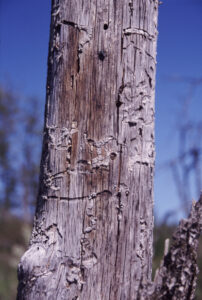
Snag with beetle tunnels now occupied for bee nests. Photo: Matthew Shepherd, The Xerces Society
Native bees come in a wide range of colors and sizes, from tiny sweat bees less than a quarter of an inch long to bumble bees over an inch in length. While some of these species may look like the familiar image of a bee with hairy yellow and black stripes, they may also be dark brown, black or metallic green and blue, with stripes of many colors. Most are solitary, with each female creating and provisioning her nest without the support of a caste system of workers. Most are unlikely to sting (Shepherd et. al., 2003).
The common names for native bees often reflect their nest building habits: miner, carpenter, mason or plasterer. Other names depict behavioral traits. For example, sweat bees drink salty perspiration to acquire nutritionally important minerals.
About 70 percent of native bees excavate underground nests (Potts et. al., 2005). Solitary bees dig narrow tunnels leading to a series of brood chambers, each one provisioned with a mixture of pollen and nectar and each holding a single egg (Michener, 2000).
About 30 percent of bees nest in wood tunnels, usually pre-existing holes such as those made by wood-boring beetles, but some will chew out the center of pithy twigs (Michener, 2000). Females of these wood-nesting bees create a line of brood cells, often using materials such as leaf pieces or mud as partitions between cells (O’Toole and Raw, 1999).
In the case of both ground-nesting and wood-nesting bees, once the nest is complete, the mother bee generally dies. Her offspring will remain in the nest, passing through the egg, larva and pupa stages before emerging as an adult to renew the cycle.
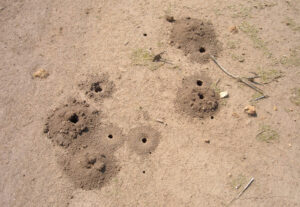
Mounds of excavated soil surround the entrance to bee nests. Photo: Eric Mader, The Xerces Society
For some species this life cycle may progress over a matter of weeks, resulting in a second generation of bees in a single season. A few species may remain dormant for over a year. Most solitary bees however complete this life cycle over the course of a full year.
Native bees often only live for a few weeks as actively flying adults. They mate immediately upon emergence and the females begin nesting. They lay relatively few eggs compared to other insects, with a single female often laying less than 50 eggs before she dies. Male bees do not live long beyond mating, they do not collect pollen and have little value as pollinators.
While most of these wood-nesting and ground-nesting bees are solitary, some are gregarious, preferring to nest near others, a behavior that allows large aggregations to develop in favorable locations. Only a few tunnel and ground-nesting bee species ever develop truly social colonies, and often such behavior is environmentally dependent with some bees being social in one situation and being solitary in another (Michener, 2000).
The one group of strictly social bees native to the United States is the group of approximately 45 bumble bee species (Kearns and Thompson, 2001). Bumble bees live in a colony with a caste system of workers, males and a single egg-laying queen. Within this social structure, bumble bees share the labor of foraging and rearing their young.

Inside of reed stem showing pollen mass and eggs. Photo: G. Neuenswonder, USDA-ARS
Similar to honey bees, bumble bees construct a wax comb; however, this comb is not a symmetrical series of hexagonal cells, but rather is an abstract configuration of round wax pots, some containing brood and some containing small amounts of pollen or nectar.
Bumble bees nest in cavities such as abandoned rodent burrows, brush piles, and grass tussocks (McFrederick and LeBuhn, 2006). The colony grows through three or four generations and, depending on the species, may have several hundred workers at the peak in mid summer. Unlike honey bees, bumble bee colonies do not survive over the winter.
Native Bee Habitat
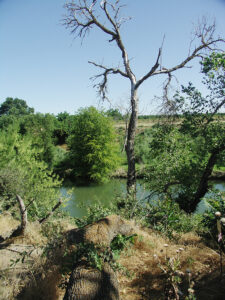
Farm pond with snag and surrounding vegetation. Photo: Mace Vaughan, The Xerces Society
Habitat for native bees has two major components: a place for the nest and flowers to forage. As detailed above, the nest site can be bare ground or a snag. The flowers can be native wildflowers or non-native weeds. Most bees aren’t too choosy; if they can reach the nectar or gather pollen, they can supply their nest. Some bees, however, are very choosy and will only gather pollen from a small number of plant species. In extreme cases, the bee may be restricted to just a single plant species. Social bees with a long-lived colony, such as bumble bees, need flowers blooming throughout the season. Solitary bees usually have a much shorter active period, often no more than five or six weeks, and have life cycles synchronized with the blooming of preferred flower species.
The two habitat components need to be close enough together so that the bees can fly between them. The flight distance of a bee varies with the size of the bee. Small sweat bees and mining bees may not fly more than 200 or 300 yards from nest to forage area (Greenleaf et. al., 2007). Large bees (bumble bees, for example) can cross half of a mile or more of inhospitable, flower-less landscape to forage. But however large the bee, if it has to fly too far the effort begins to outweigh the benefits and the bee may either find somewhere else to nest or not survive in the landscape.
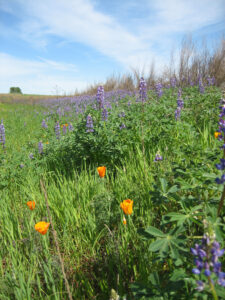
Wildflowers planted to create on-farm habitat. Photo: Katharina Ullmann, The Xerces Society
A third factor that influences habitat is insecticide exposure. To thrive, bees need minimal exposure to pesticides.
Native Bees as Crop Pollinators
Among the food crops requiring bee pollination are almonds, apples, blackberries, blueberries, cherries, cranberries, pears, plums, squash, tomatoes and watermelons. Oil and biofuel crops requiring bee pollination include canola and sunflower. Even meat and dairy industries are dependent on bee pollination for the production of forage seed such as alfalfa and clover.
Producers of these crops should consider the needs of native bees in their farm management because these insects may provide increasing yields and farm profit, and reduce reliance on rented honey bees. Native bees also provide an insurance policy if rental honey bees are prohibitively expensive or difficult to obtain.
Native Bee Efficiency
Many native bee species are more effective than honey bees at pollinating flowers on a bee-for-bee basis. For example, according to U. S. Department of Agriculture researchers, only 250 female blue orchard bees (Osmia lignaria) are required to effectively pollinate an acre of apples. The is the equivalent service of one to two honey bees hives, each containing 15,000 to 20,000 workers (Bosch and Kemp, 2001).
The reason for this increased efficiency is the mason bee’s greater tolerance for cold and wet weather. In addition, the foraging behavior is different in native bees than in honey bees. For example, individual honey bee workers specialize in the collection of either pollen or nectar. Nectar-foraging honey bees often never contact the anthers (pollen-producing structures) in apples, unlike mason bees that must collect both pollen and nectar (Bosch and Kemp, 2001).
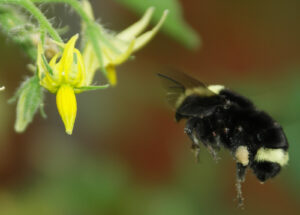
Yellow-faced bumble bee approaching tomato flower. Photo by Mace Vaughan, The Xerces Society
Alfalfa flowers provide another example of native bee efficiency. The stamen (the structure holding the anthers) of alfalfa flowers is held under tension by two flower petals, and springs forward with force when released by a visiting bee. This triggering discourages many bees, including honey bees, who learn to avoid being hit by the stamen by approaching the flower from behind, where they can gather nectar but not pollen. The alkali bee (Nomia melanderi), a native ground-nesting bee, is not discouraged by this unusual flower structure and is a major pollinator of alfalfa seed in some western states (Mader et. al., 2010).
Some native bees are highly efficient because they specialize in one type of flower. Squash bees (genus Peponapis), for example, primarily visit flowers from the squash family (Tepedino, 1981). Female squash bees often start foraging before dawn and the males even spend the night in squash flowers.
Another efficiency of native bees is the process of buzz pollination. Bumble bees in particular are notable for their ability to grasp a flower and vigorously vibrate their flight muscles, releasing pollen from the anthers. This behavior is very important for some plants such as blueberries, cranberries, tomatoes and peppers, all of which release pollen from pores within the anthers (similar to salt being shaken from a salt shaker) (Mader et. al., 2010).
Assessing Native Bee Habitat on Farms
Many growers may already have an abundance of habitat for native pollinators on or near their land. Having semi-natural or natural habitat available significantly increases pollinator populations (Kremen et. al., 2004 and Williams and Kremen, 2007). Linear habitats along field edges, hedgerows and drainage ditches offer both nesting and foraging sites (Carvell et. al., 2004). Woodlots, conservation areas, utility easements, farm roads and other untilled areas may also contain good habitat. Often, marginal areas that are less fit for crops may be managed as pollinator habitat (Morandin and Winston, 2006). Here are some tips on recognizing specific resources so that they can be factored into farm planning.
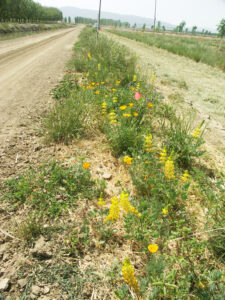
Trackside wildflowers provide useful habitat. Photo by Mace Vaughan, The Xerces Society
Existing Plant Composition
When assessing pollen and nectar resources, it is important to look at all of the plants on and around a farm. These plants include insect-pollinated crops, as well as the flowers – even weeds – in buffer areas, forest edges, roadsides, natural areas, fallow fields and more. Insect-pollinated crops may supply abundant forage for short periods of time. However, for pollinators to be most productive, nectar and pollen resources are needed outside the period of crop bloom.
As long as a plant is not invasive, consider letting some of the native or non-native weeds and wildflowers bloom. For example, dandelions, clover and other non-native plants are often good pollinator plants in orchards.
Keep in mind that small bees may only fly a couple hundred yards, while large bees, such as bumble bees, easily forage a mile or more from their nest (Greenleaf et. al., 2007). Therefore, taken together, a diversity of flowering crops, wild plants on field margins and plants up to a half-mile away on adjacent land can provide the sequentially blooming supply of flowers necessary to support resident pollinators.
Existing Nest Sites
Look for nest sites around the property. Nests of ground-nesting bees are likely to occur in semi-bare patches of soil. Wood-nesting bees will be in snags or shrubs with soft-centered twigs (Michener, 2000). Bumble bees may be nesting in old rodent burrows or brush piles.
Most bees are active on warm sunny days, from mid morning through the afternoon. Some, however, may be active early in the morning (for example, squash bees), while others will continue flying late in the evening (bumble bees). Anywhere from one to thousands of bees may be present at a nest site and they may be as small as a medium-sized ant (less than a quarter inch) to larger than a honey bee (three-quarters of an inch).
In the case of ground-nesting solitary bees, the nest entrance will be visible only when the adults are active, the timing of which varies from species to species. The nests that these bees occupy appear as small holes in the ground, often with piles of excavated soil around the entrance. In some cases, they may look like the entrance to an ant nest, although often with a larger entrance hole.
Pollinator-friendly Farming
In addition to conserving the food and nest sources of native bees, you can take an active role in protecting bees through the adoption of pollinator-safe farming practices. While insecticides are an obvious threat to bees, other farm operations or disturbances such as burning and tilling can also cause harm.
Minimizing Pesticide Use
Insecticides not only kill pollinators (Johansen, 1977), but sub-lethal doses can affect their foraging and nesting behaviors, often preventing plant pollination and bee reproduction (Thompson, 2003; Decourtye et. al., 2004; and Desneaux et. al., 2007). Herbicides can kill plants that pollinators depend on when crops are not in bloom, thus reducing the amount of forage available (Kremen et. al., 2002; Tscharntke et. al., 2005).
In general, while pesticide labels may list hazards to honey bees, potential dangers to native bees are often not listed. For example, many native bees are much smaller in size than honey bees and are affected by lower doses. Also, honey bee colonies may be covered or moved from a field, whereas wild native bees will continue to forage and nest in spray areas.
If pesticides cannot be avoided, they should be applied directly on target plants to prevent drift. Broad-spectrum chemicals should be avoided if at all possible. In addition to active ingredients, consider the formulation of pesticides; generally dusts and fine powders that may become trapped in the pollen-collecting hairs of bees and consequently fed to developing larvae are more dangerous than liquid formulations (Vaughan et. al., 2007).
Crops should not be sprayed while in bloom. Nighttime spraying, when bees are not foraging, is another way to reduce bee mortality. Periods of low temperatures may also be good for spraying because many bees are less active. However, the residual toxicity of many pesticides tends to last longer in cool temperatures. For example, dewy nights may cause an insecticide to remain wet on the foliage and be more toxic to bees the following morning, so exercise caution (Vaughan et. al., 2007 and Johansen and Mayer, 1990).

Calibrating sprayer nozzles. Photo: USDA-ARS
Spray drift presents another threat to foraging native bees. Drift can occur either as spray droplets or vapors, as happens when a volatile liquid changes to a gas. Factors affecting drift include temperature (including temperature inversions), wind, application method, equipment settings and spray formulation (Ozkan, 2000).
Spray application methods and equipment settings also strongly influence the potential for drift. Since small droplets are most likely to drift long distances, aerial applications and mist blowers should be avoided. Standard boom sprayers should be operated at the lowest effective pressure and with the nozzles set as low as possible. For example, drop nozzles can be used to deliver insecticide within the crop canopy where it is less likely to be carried by wind currents. Regardless of the chemical or type of application equipment used, sprayers should be properly calibrated to ensure that excess amounts of pesticide are not applied (Ozkan, 2000).
Alternatives to conventional insecticides include the use of selective products that target a narrow range of insects, such as Bacillus thuringiensis (Bt) for moth caterpillars, although even these products can be detrimental when they drift. Other alternatives for some pests include bug vacuums, pheromones for mating disruption and kaolin clay barriers for fruit crops. Several ATTRA publications are available to assist farmers with implementing non-chemical pest control alternatives. See ATTRA’s Sustainable Pest and Weed Control Database for information on specific product and pests. Finally, remember that many of the habitat features that support pollinators will also host beneficial insects that help control pests naturally, reducing the need for pesticides.
Minimizing the Impact of Mowing, Haying, Burning, or Grazing
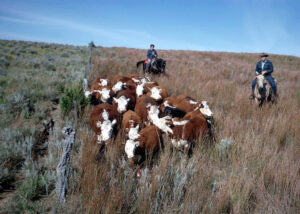
Contrast in vegetation due to grazing. Photo: Irv Cole, USDA-NRCS
Grazing, haying, mowing and fire can have damaging effects on pollinators (Black et. al., 2008). Historically, there were sufficient areas of diverse vegetation to support populations of habitat specific pollinators. However, now that many of these areas exist only as fragments in larger agricultural landscapes, consideration of pollinators is needed to ensure healthy populations.
Studies suggest that less than one-fifth of pollinator habitat should be burned, mowed or hayed at any one time in order to protect dormant pollinators, foraging adults and other wildlife. This will allow for re-colonization of the disturbed area from nearby undisturbed refugia (Hartley et. al., 2007). In order to maximize foraging and nesting opportunities, maintenance activities should be avoided while plants are in flower (Smallidge and Leopold, 1997). Ideally, mowing or haying should be done only in the fall or winter.
Grazing can be a valuable tool. However, grazing is usually only beneficial at low to moderate levels and when the site is grazed for a short period followed by ample recovery time — and when it has been planned to suit the local site conditions.
Protecting Bee Nests
Native bees often nest in inconspicuous locations. It is important to retain as many naturally occurring sites as possible and to create new ones where appropriate.
Ground-nesting bees seldom nest in rich soils, so poor quality sand or loamy sand soils may provide fine sites. In order to protect nest sites of ground-nesting bees, tilling and flood-irrigating areas of bare or partially bare ground that may be occupied by nesting bees should be avoided (Shuler et. al., 2005 and Vaughan et. al., 2007).
Grazing such areas can also disturb ground nests. And fumigants for the control of soilborne crop pathogens (such as Verticillium wilt), or covering large areas with plastic mulch can be detrimental to beneficial ground-nesting insects such as bees.
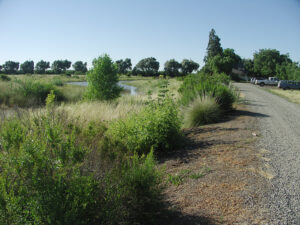
Areas of brushy vegetation will off er nest sites for bumble bees. Photo: Mace Vaughan, The Xerces Society
Weed control alternatives to tillage that are safer for ground-nesting bees include the use of selective crop herbicides, flame-weeders and hooded sprayers for between row herbicide applications.
Leaving patches of un-mowed grass in which rodents can nest will create future nest sites for bumble bees. Bunch grasses tend to provide better nesting habitat than sod-forming varieties. Structural landscape features such as brush and stone piles also provide nesting habitat for bumble bees.
For wood-nesting bees, allow snags and dead trees to stand as long as they do not pose a risk to property or people.
Providing Alternative Forage
Undeveloped areas on and close to farms can serve as long-term refuge for native wild pollinators. Protecting, enhancing or providing habitat is the best way to conserve native pollinators and, at the same time, provide pollen and nectar resources that support local honey bees. On farms with sufficient natural habitat, native pollinators can provide all of the pollination for some crops.
Such habitat can take the form of designated pollinator meadows (bee pastures), orchard understory plantings, hedgerows and windbreaks with flowering trees and shrubs, riparian and rangeland revegetation efforts, flowering cover crops and green manures, and other similar efforts.
Where possible, locally native plants are often preferred for their ease of establishment, greater wildlife value and their co-evolution with native pollinators (Kearns et. al., 1998). Non-native plants may be suitable on disturbed sites, for specialty uses such as cover cropping and where native plants are not available. Mixtures of native and non-native plants are also possible, as long as non-native species are not invasive.

Field edge hedgerow, with natural area is background; nearby habitat supports pollinator populations. Photo by Mace Vaughan, The Xerces Society
Distance from Fields
The typical foraging distance of native bees ranges from about 50 feet to a half-mile, with larger species able to fly farther. To be of greatest benefit to crop production, areas of natural habitat should be within a half-mile of an insect-pollinated crop. Ideally, potential nesting sites would be even closer (a couple of hundred yards), in order to increase the number of small bees reaching a crop in bloom.
Size of Habitat
Studies in California demonstrate that around 30 percent of the land within three-quarters of a mile of a field should be in natural habitat in order to provide full pollination for watermelon (Kremen et. al., 2004). Similarly, studies in Canada have shown that in the absence of honey bees canola farmers can increase their income because of increased pollination by native bees if 30 percent of their farmland is left in natural habitat (Morandin and Winston, 2006). In a mixed landscape straddling the New Jersey-Pennsylvania border, crops of tomatoes, peppers and watermelons all received high visitation from native bees because of the presence of woodlands (up to 60 percent of the land within 1.25 miles of a field) and other habitat areas between fields (Winfree et. al., 2008).
Scientists and growers are still learning about how much habitat is needed for other crops. In general, a sound strategy is to make habitat patches as large as feasible within the constraints of a farm and to create as many patches as possible. Larger areas of habitat ensure a greater likelihood that forage, nest sites and nest building materials will be available within the bees’ flight range and throughout the flight season.

Hedgerow and woodlots close to fields (within flight range) support native pollinator populations. Photo: Scott Bauer, USDA-ARS.
Habitat corridors
Cultivated fields have replaced most of the natural habitat in many modern agricultural landscapes, resulting in significant distances between areas of habitat that harbor native pollinators. Continuous, permanent strips of vegetation can link these patches and potentially increase the rate at which pollinators and other wildlife colonize new areas of habitat near agricultural fields. They also may serve to grab the attention of bees flying across the landscape. These long narrow habitat features can aesthetically enhance drainage ditches, fencerows and roadsides. Increased connectivity, particularly between larger areas of natural habitat, will bring a greater overall benefit.
Select Plants that Complement the Crop
Most bees emerge before crops come into bloom and many bee species are still active afterward the crop bloom period. Therefore, plenty of forage should be available before and after a particular crop comes into bloom. This timing will attract bees and ensure that they can successfully raise many young.
If a farm already grows a diversity of crops, the timing of flowers produced by non-crop plants is less of a concern and the crops themselves help provide a sequence of bloom.
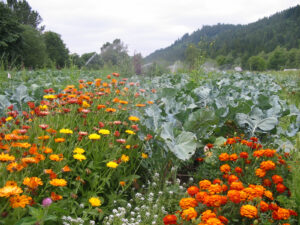
Insectary plants used within field as crop row-end markers. Photo: Matthew Shepherd, The Xerces Society
For example, vegetable farmers might allow some salad, root and herb crops to bolt. In addition to pollinators, the predators and parasitoids of many pests are attracted to the flowers of plants like dill, cilantro, arugula, chervil, chicory, mustards, carrots and radishes.
Finally, avoid plants that serve as alternate pest and disease hosts and plants that are likely to become weeds in the primary crop.
Technical and Financial Assistance
Technical support and financial incentive programs are available to landowners who are interested in setting aside, enhancing or restoring some of their land for pollinator habitat in the United States.
Several USDA programs administered through the Natural Resources Conservation Service (NRCS) provide planning assistance and financial support for the creation of new wildlife habitat, and in some cases actual rental payments to growers. Among the most well known of these programs is the Conservation Reserve Program (CRP), which pays landowners for the conversion of marginal cropland to a less intensive use (Vaughan and Skinner, 2009).
Historically these programs were intended to reduce erosion, protect water quality and provide habitat for wildlife such as pheasants and whitetail deer. Language in the 2008 Farm Bill, however, has made the promotion and conservation of pollinator habitat a priority among USDA conservation programs.
In many states, three programs, the Wildlife Habitat Incentives Program (WHIP), the Environmental Quality Incentives Program (EQIP) and the Conservation Stewardship Program (CSP), offer specific technical and financial support for pollinator conservation (usually native wildflower plantings) on farms (Vaughan and Skinner, 2009).
In many cases, these programs can also be used for multiple purposes. For example, plants attractive to pollinators could be used in a grassed waterway with the primary objective of stabilizing a hillside against erosion.
For information about these conservation programs, contact your nearest USDA NRCS office. Locations can be found here.
Creating Artificial Nest Sites
There are a number of ways to provide nesting sites for different kinds of native bees, from drilled wooden blocks to bundles of reeds to sand pits or adobe bricks (Shepherd et. al., 2003 and Vaughan and Black, 2006). Generally, increasing nesting opportunities will increase bee numbers. However, to be sustainable, artificial nests need to be maintained over time to prevent the buildup of parasites and disease (Bosch and Kemp, 2001 and Mader et. al., 2010).
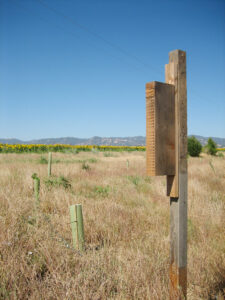
Drilled wood blocks offer nesting opportunities for many native bees. Photo: Katharina Ullmann, The Xerces Society
Nesting Sites for Ground-nesting Bees
The precise conditions needed by most ground-nesting bees are not well known. Some species nest in the ground at the base of plants, and others prefer smooth, packed bare ground. You can create conditions suitable to a variety of species by maximizing areas of untilled ground and preparing designated areas of bare soil.
Soil piles might be constructed with soil excavated from drainage ditches or silt traps. Different species of bees prefer different soil conditions, although research shows that many bees prefer sandy or sandy loam soils. For a more formal look, make raised sand beds edged with lumber or bricks. Alternatively, you can create a sandpit by simply digging a pit 2 or 3 feet deep, and fill it with fine-grained, pale-colored sand or a sand-loam mixture (Vaughan and Black, 2006).
These nesting areas can be as small as 1-2 square feet, but preferably should be several yards side. Your site can be level or sloping, but it should be well-drained, open and sunny. Place a few rocks in the cleared area; they will retain heat and bees will bask on them (Shepherd et. al., 2003).
Colonization of these nest sites will depend on which bees are already present in the area, their successful reproduction and population growth and the suitability of other nearby sites.
Maintenance of Nests for Ground-nesting Bees
In general, ground-nest sites should receive direct sunlight and dense vegetation should be removed regularly by mowing, hand weeding or spot treating with herbicide, making sure that some patches of bare ground are accessible. Once constructed, try not to walk or drive across the site. Remember that buried under the ground are possibly hundreds of bees.
Nests for Wood-nesting Bees
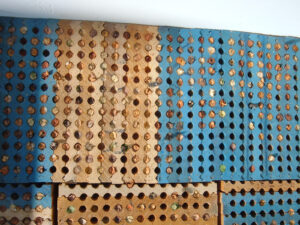
Nests made from stacks of grooved boards can be opened easily to clean the tunnels. Photo: Eric Mader, The Xerces Society
Commercially produced bee blocks, consisting of a wood block drilled with a series of dead-end holes, are now widely available. These types of bee nests were initially developed in the 1960s by alfalfa seed producers in the western United States to attract and manage large numbers of the non-native alfalfa leafcutter bee (Megachile rotundata). More recently they have been modified to manage the blue orchard bee (Osmia lignaria), a bee that is active only in the spring and will not pollinate later-flowering fruits and vegetables. Consequently, all of the nest tunnels are a uniform size and depth, which may be either too large or too small for many other species. Nest blocks with a greater diversity of hole sizes and depths are necessary to attract a variety of bees that are active throughout the year (Mader et. al., 2010).
Under the best circumstances these nests can attract large numbers of cavity-nesting bees and boost their local populations. However, because these nests concentrate bee populations in unnaturally large numbers in a small space, they can become infested with parasites and disease spores after several seasons.
Without regular sanitation or the phasing out of nest materials, these parasites and diseases threaten long-term pollinator health wherever they are used. Because contaminated nest blocks left unattended in the landscape continue to attract wild bees from the surrounding area, they have the potential to do harm (Mader et. al., 2010). Only with proper management can these nests maintain healthy bee populations indefinitely.
Wooden Blocks
Use preservative-free dimensional lumber to construct wooden nest blocks. A four-byfour is appropriate for blocks with smaller diameter holes. A four-by-six works for blocks with larger diameter holes.
In one side, drill a series of nest holes of appropriate sizes and depths. Nesting holes should be between 3⁄ 32 and 3⁄ 8 inch in diameter. Holes of 1⁄4 inch or less in diameter should be 3 to 5 inches deep. Holes larger than 1⁄4 inch should be 5 to 6 inches deep (Bosch and Kemp, 2001; Shepherd et. al., 2003). The female bee controls the gender of her offspring and usually finishes the nest with a few male brood cells. A deeper hole ensures space for more female brood.

Blue orchard bee nests in cherry orchard. Photo by G. Neuenswonder, USDA-ARS.
The holes should be about 3⁄4 inch from center to center and no closer than that to the edges of the block. Attach a backing board if you drill all the way through your block, because bees will not use a drilled hole that is open at both ends. With smaller diameter drill bits, you may not be able to achieve the 3-inch minimum recommended depth. If that is the case, simply drill as deep as you can; bees that use holes of smaller diameters will often nest successfully in ones that aren’t as deep.
Bees may avoid a rough interior, so your holes should be perpendicular to the wood’s grain and drilled with a sharp bit. You can buy paper straws to line the holes, although it may be hard to find straws that fit all diameters. One solution is to wrap your own paper straws out of parchment or newspaper using dowels of various diameters that match the inside diameters of your drilled holes. Paint the outer tips of the straws black to help attract bees (Bosch and Kemp, 2001).
The exterior of the block can be any color, although there is some anecdotal evidence that bees are most attracted to dark blocks, which can be achieved by lightly charring the front surface with a propane torch. Whatever the color, bees are likely to use the block as long as the holes are of appropriate diameters and depths, and hung in an appropriate location. As a final step, you can attach an overhanging roof to provide additional shelter from the rain.
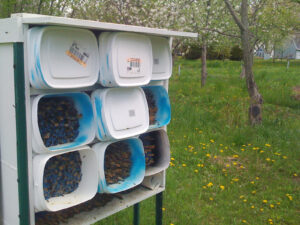
Bamboo nest units in orchard. Photo by Eric Mader, The Xerces Society
Colonization is often more successful when blocks are attached to a large visible landmark such as a building. The actual height from the ground does not much matter, although if the nest is too low (less than a few feet), rain splash may dampen it and vegetation may cover it. Nest blocks should be hung in a protected location where they receive strong indirect sunlight. Direct sunshine in the morning will help bees warm themselves up to flight temperature, so you may wish to place nests facing east, allowing the morning sun to fall on the entrance holes. Direct sunlight later in the day can be detrimental, causing eggs or developing brood to overheat and die (Shepherd et. al., 2003).
Since these types of nests mimic trees frequented by woodpeckers, do not be surprised if a one finds your nest. To protect against damage, you might want to store your nests in an unheated building at the end of the season. Alternatively, you can protect nests over the winter by surrounding them with hardware cloth. Be sure to remove the cloth before nesting resumes because hardware cloth can disorient nesting bees and damage their wings (Mader et. al., 2010).
Stem Bundles
In addition to wooden blocks, artificial nests can be constructed with bundles of reed, teasel, cup plant, or bamboo cut so that a natural node forms the inner wall of the tunnel.

Blue orchard bee closing nest in bamboo tube. Photo by Mace Vaughan, The Xerces Society
Cut each stem below the nodes (usually indicated by a ridge) to create a handful of tubes, each with one open end. Strap the tubes together into a tight bundle with wire, string or tape, making certain that the closed ends of the stems are all at the same end of the bundle. A variation on this is to tightly pack the stems — open ends out — into a tin can, paper milk carton, square plastic buckets or short section of PVC pipe. The bundles should be placed in a sheltered location (such as the side of a barn or garden shed) with the stems horizontal to the ground.
Adobe Blocks
Some solitary bees nest in cracks or cavities in soft sandstone and dry exposed soil embankments. Some of these species, such as Anthophora abrupta and Anthophora urbana, will excavate tunnels in cliff sides by wetting the hard soil surface with water or nectar to soften it. These two species are important visitors of some fruit and vegetable crops and are quite common in the southeastern and southwestern United States, respectively.

A plastic bucket makes a convenient
container for bamboo or reed stems.
Photo by Eric Mader, The Xerces Society.
To attract these species, adobe bricks can serve as the equivalent of a wooden nest block. Such bricks can sometimes be purchased, in which case you can increase their attractiveness to bees by drilling nesting holes following the size recommendations listed above for wood blocks.
Adobe blocks can also be easily made where clay soils are common. To create one, half-fill a large bucket with clay soil, and then fill the bucket with water. Stir the mixture together to create a muddy slurry and allow it to settle. Remove any sticks or debris floating on the surface and slowly pour off most of the water. Finally, pour the remaining sediment into a mold (such as a wooden box or small Styrofoam cooler), and allow it to dry for several days or weeks. Before it completely dries, you can make several 1-inch indentations, using the diameter guidelines above, to make it more attractive to bees.
Mount the brick, either singularly or in a stack. Adobe will not hold up well in wet climates and many need sheltering from rain. You might want to supply a shallow water source near your bricks to help bees excavate their nests.
Nesting Materials
In addition to nesting holes, different species need different materials to build their brood cells, which consist of intricate walls that partition off the tunnel into a series of separate chambers. These partitions seal the nest entrances and protect the brood from predators.
Depending on the species, these walls may be constructed of mud, plant resins, pieces of leaf, flower petals, fine pebbles and even cellophane-like glandular secretions (O’Toole and Raw, 1999). It is likely that these materials are already present in your area, but if you provide a diversity of native plants and some mud puddles, you can guarantee it.
Keep in mind that bees may not fill the entire length of a tunnel with cells, or they may die before an entire length of a cavity is filled. For these reasons it can be difficult to tell if a nest tunnel is occupied by just looking for sealed entrances.
Maintenance of Tunnel-nests
Whether your nests are wooden blocks, twig bundles or other materials, nests will need routine management in order to be sustainable. Nests also need regular replacement to prevent the build-up of parasites and diseases that affect the developing brood.

Inside of bamboo stem showing clean, healthy cocoons. Photo: Eric Mader, The Xerces Society
The hardest of these to control is chalkbrood (Ascosphaera spp.), a fungal disease. Several species of the fungi exist among tunnel-nesting bees, all of which are different from the chalkbrood disease that attacks honey bees. Bee larvae become infested with disease spores through contaminated pollen, either collected from a flower by the mother bee or accidentally spread when the mother bee emerges from a contaminated nest cavity (Mader et. al., 2010).

Inside of bamboo stem showing nest infected with chalkbrood. Photo: Eric Mader, The Xerces Society
After they are ingested, the chalkbrood spores germinate inside the gut of the developing larva, producing long filaments (hyphae) that eventually penetrate the gut wall, killing the larva. As the filaments continue to grow below the skin of the deceased larva, they eventually produce dark-colored spores. The appearance of infested cadavers thus varies from white to grey to black depending on the stage of fungal development. These brittle cadavers pose a hazard to bees deeper within the nest block that, upon emergence, must climb over or chew through the spore-infested cell to escape the nest. Bees that emerge under these circumstances have a high likelihood of spreading the spores to their own offspring. Similarly, bees searching for new unoccupied nest tunnels in which to lay their eggs frequently investigate, and often select, previously used tunnels. Over time, chalkbrood spores are spread throughout a nest block in this way (Mader et. al., 2010).
Along with chalkbrood, pollen mites in the genus Chaetodactylus can be a persistent problem in nest blocks that are in continuous use for several seasons. Unlike the mites that attack honey bees, pollen mites do not feed on the hemolymph (blood) of the bee. Instead, pollen mites feed on the pollen provision, causing the developing bee larva to starve (Mader et. al., 2010).
Adult pollen mites are usually white in color and measure about 500 microns in width, about the size of the period at the end of this sentence. As with chalkbrood, adult bees may accidentally pick up mites at flowers while foraging, or from climbing through or investigating contaminated nest cavities. Migratory nymph stages of the mites cling to a bee’s hairs and are transported back to the nest, where they feed on the pollen provision and reproduce rapidly. In a single provisioned cell, mite numbers can quickly climb into the thousands. While pollen mites usually cannot break through cell partitions, they can persist for many months without food, until a bee deeper within the nest emerges from the tunnel and breaks the partition walls, allowing them to escape. It is not uncommon to see bees emerging from infested nest blocks covered with so many migratory mite nymphs that they have difficulty flying (Mader et. al., 2010).
To reduce these parasite and disease problems, we recommend one of three approaches:
1. The holes of wood nest blocks can be lined with tight-fitting removable paper straws. At the end of the nesting season (autumn), the straws are gently removed, placed in a ventilated container and stored either in a refrigerator or an unheated barn or garage. The nest block is then disinfected by submerging it in a weak bleach-water solution (1:2 ratio) for a few minutes. In the spring, fill the block with clean, previously unused paper straws and return it to its location. The old straws (with bees in them) are placed alongside the nest block, and the bees are allowed to emerge naturally. When the old straws are empty, they are disposed of.
2. Wood and adobe nest blocks and stem bundles can be phased out every two years by placing the blocks and bundles inside a dark container, such as a light-proof wooden box or even a sealed milk carton that has been spray painted black to reduce light infiltration. A single 3/8-inch exit hole is drilled in the bottom of the light-proof container and the entire contraption is hung adjacent to a new, previously unused nest block or stem bundle. As bees emerge from the old nest, they are attracted to the light of the exit hole and emerge to find the new one hanging nearby. The old nest block or stem bundle is then disposed of at the end of the season.
3. The last alternative is to create multiple small nest blocks or stem bundles with only a few nest tunnels (four to six) and hang them at intervals of 25 feet or more. This prevents the unnaturally high populations of bees found at nest blocks with many holes and mimics natural conditions of limited, spatially separated nest sites. These smaller nests also decompose more rapidly and can be allowed to simply deteriorate naturally, while new small nests are added to the landscape periodically.
Nest boxes for bumble bees
Unlike solitary bees, which can be very particular about tunnel diameters, bumble bees are flexible in their nesting needs. All they want is a warm, dry cavity, roughly the size of a shoebox (Shepherd et. al., 2003). Artificial nests can be constructed to attract bumble bees, but occupancy is typically extremely low — often far less than 25 percent.
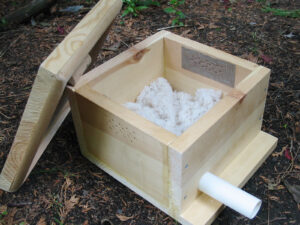
Bumble bee nest box showing construction. Photo: Matthew Shepherd, The Xerces Society
A simple wooden bumble bee box can be made from preservative-free lumber. An appropriate size will have internal dimensions of about 7 inches high by 7 inches wide and 7 inches long. Drill a few ventilation holes on the upper sides of the box (near the roof) and cover with window screen to deter ants. Also drill some drainage holes in the bottom. Make an entrance tunnel from 3⁄4-inch diameter plastic pipe and fill the box with soft bedding material, such as short lengths of soft unraveled string, dry straw or upholsterer’s cotton (do not use cotton balls, as the fibers become tangled in the bees’ legs). The box must be weathertight; if the nest gets damp, the larvae may become too cold and mold and fungus will grow.
Place the nest in a dry, undisturbed area that has some obvious landmarks (a fence post, rock or building) to aid bee navigation; these landmarks important to bees returning from foraging. Nesting boxes that are at ground level or slightly buried (either with soil or straw) are the most attractive to queens of many species. Boxes placed on the surface should be level and stable. If you are burying your box, extend the entrance pipe so it gently slopes up to the surface and clear the vegetation from an area a few inches around where the pipe surfaces.
The best time to install a bumble bee nest box is in early spring, when the first queens have emerged from hibernation and are searching for a nest site; in many areas, this is when the willows first start blooming.
Maintenance of Bumble Bee Nests
Bumble bee nests require little maintenance. Watch your boxes through the spring and early summer. Any above-ground boxes that are unoccupied by late July can be removed, cleaned, and put into storage until the following spring. This is not vital, and if you have a lot of boxes on a large site it may not be practical. In late fall or early winter, inspect all the boxes that have been occupied. Remove the old nests, clean them and make any repairs. Cleaning the boxes with a mild bleach-water solution (1:2 ratio) will help reduce parasites and diseases in the nests. The following spring, add fresh nesting material to all the boxes.
Commercial Native Bee Production
Recently, many people have become interested in the blue orchard bee (Osmia lignaria), also called the orchard mason bee, as a garden and orchard pollinator. Many thousands of mason bee nesting blocks are sold each year in the United States, along with hundreds of thousands of blue orchard bees. This interest has greatly raised public awareness about the importance of pollinators; however, it is important to remember that raising large numbers of a single species (bee-ranching) is a different objective than the conservation of diverse species of wild pollinators.
As mason beekeeping has increased in popularity, important questions are being asked about the risks associated with the nationwide shipment of blue orchard bees by commercial producers. In fact, there are two distinct subspecies of the blue orchard bee: Osmia lignaria propinqua in western North America and Osmia lignaria lignaria in the eastern United States. The species is rare in the Great Plains region, although some intermediate specimens have been collected.
Most commercial producers of the blue orchard bee are located in the Pacific Northwest, where they rear the locally native western subspecies (Mader et. al., 2010). Unfortunately, the bees these producers raise are then marketed nationwide, resulting in the frequent shipment of locally non-native bees to the eastern United States. The potential ecological consequences of the western blue orchard bee hybridizing with its eastern subspecies are unknown. Similarly, these shipments have the potential to introduce locally non-native parasites and diseases. For the consumer, there is another significant drawback. The western bees may not develop in sync with local conditions, resulting in poor establishment and poor performance as pollinators. The net result is that people purchasing blue orchard bees over the Internet or through garden catalogs may be doing more to harm their local pollinator populations than to help them — and not be getting the pollination they paid for.
Similarly, the package bumble bee industry, which provides farmers with live bumble bee colonies for crop pollination, currently only produces a single eastern bumble bee species, Bombus impatiens. This species is then shipped nationwide, in a situation similar to the blue orchard bee, often far beyond its native range. Many bumble bee scientists now believe that these commercially produced bumble bees are responsible for the introduction of one or more diseases which have decimated several bumble bee species, even causing the potential extinction of one species, Bombus franklini (Franklin’s bumble bee) (Evans et. al., 2008).
There is an enormous need for managed agricultural pollinators in this country, but it critical not to import non-local bees, especially near wild areas, even if the bees are represented as being the same species as local bees. The alternatives are to either develop local commercial sources of bees that are native to your region or to rear already widely established non-native species, such as honey bees or the alfalfa leafcutter bee, as managed pollinators.

Metallic green sweat bee. Photo: Susan Ellis, Bugwood.org
Common Native Bees
Globally, bees are grouped into seven families. Six of these have species in North America, although only five, the Colletidae, Andrenidae, Halictidae, Megachilidae and Apidae, are commonly encountered. The family Melittidae is represented only by about 60 generally uncommon species in North America (Michener, 2000 and O’Toole and Raw, 1999).
Colletidae: Polyester Bees
Bees in the family Colletidae are highly varied in appearance and have few common features. One feature consistent to all colletid bees is that their tongue has a branched tip. Colletids secrete a plastic-like substance (hence the family’s common name) that they use to waterproof their brood cells. This allows the bees to nest in periodically flooded areas such as stream banks. The two genera most frequently seen are Colletes and Hylaeus.
Andrenidae: Mining Bees
With just over 1,400 hundred species in North America, Andrenidae is the most diverse family of bees on the continent. Andrenidae are abundant in the spring and, as their common name indicates, excavate nests in the ground. They generally nest in flat or gently sloping sites and may form aggregations with tens of thousands of bees nesting in a small area. The huge majority of species in this family are solitary. A small number of species are communal, with several females sharing a nest entrance but each excavating and provisioning their own brood cells. They generally nest in flat or gently sloping sites and may form aggregations with tens of thousands of bees nesting in a small area. Commonly encountered genera are Andrena and Perdita.
Halictidae: Sweat Bees
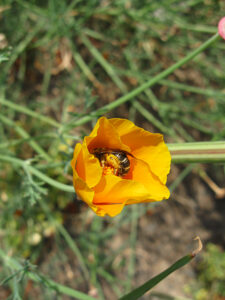
Sweat bee foraging in California poppy. Photo: Matthew Shepherd, The Xerces Society
Halictidae are among the most frequently encountered bees during summer. Although this family includes brightly colored metallic bees, the majority of halictids are drably colored and small. Most Halictidae excavate nests in the ground, though some nest in rotting wood. The genus Lasioglossum includes the whole gamut of social behaviors from solitary to semi-social (nests constructed by a group of bees in which one is the egg-laying queen). The bright green Agapostemon is communal; a dozen or more females may share a nest entrance, but underground each bee creates her own brood cells. Other common genera in this family are Halictus, Augochlora, Nomia, and Augochlorella.
Megachilidae: Leafcutter and Mason Bees
Megachilidae is one of the easiest families to recognize because its members don’t carry pollen on their legs. Instead, they have rows of stiff hairs on the underside of their abdomen into which they pack dry pollen for transport back to the nest. The great majority of megachild bees nest in existing cavities above ground (beetle tunnels in snags, crevices in rocks) and collect items such as leaf pieces or wet soil to divide the nesting tunnel into brood cells. This family includes the commonly managed leafcutter (Megachile) and mason bees (Osmia).
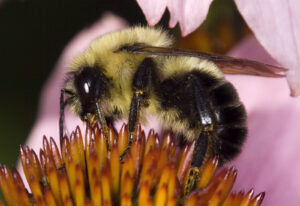
Common eastern bumble bee nectaring on purple coneflower. Photo: David Cappaert, Michigan State University. Courtesy of Bugwood.org
Apidae: Bumble, Carpenter, and Other Bees
The Apidae is an immensely diverse family that includes bumble bees (Bombus) as well as a wide range of less well-known yet frequently encountered groups such as the digger (Anthophora), squash (Peponapis) and sunflower (Svastra) bees. Given the diversity of its genera, it will come as no surprise that the Apidae displays the full range of nesting behaviors from solitary to social and has species that nest in the ground, in wood and in old rodent burrows. Other genera in this family include Xylocopa, Ceratina, Diadasia, Eucera, and Melissodes.
Case Study: The Alkali Bee
Adult alkali bee on ground (excavating nest?) Nomia adult (James Cane). Photo credit should read: Photo by James L. Cane, USDA ARS.
The requirements of one ground-nesting species, the alkali bee (Nomia melanderi), are so well understood that artificial nesting sites are created to provide reliable crop pollination for alfalfa in eastern Washington and Idaho.
Adult alkali bee on ground. Photo: James L. Cane, USDA-ARS
Forage producers first recognized the alkali bee’s affinity for alfalfa blossoms in the 1940s. The alkali ground-nesting bee is native to arid regions west of the Rocky Mountains, Following the development of management techniques in the late 1950s, growers using the alkali bee have produced astounding yields of up to 2,400 pounds of cleaned seed per acre — this in the normally unproductive desert regions of the Great Basin.
In the wild, the alkali bee excavates nests in the crusted-over soils of alkali flats. In these areas, the capillary action of high water tables draws water to the soil surface where salt crystals and minerals are deposited as the water evaporates. These minerals form a thin crust limiting further evaporation and maintaining a moist nesting environment in the otherwise arid region of the bee’s native range. Under optimal conditions a single cubic foot of these alkaline soils may contain up to 50 nests.
Because they are ground nesters, alkali bees cannot be easily transported and their usefulness is confined to arid locations — typically flat alkaline desert soils. Within these playas (or salt flats), individual bee nests are usually located in the upper 8 inches of soil and consist of tunnel entrances with a series of brood chambers located below the surface.
The alkali bee is susceptible to habitat loss from grazing and off-road vehicle use and now is uncommon in parts of its original range. However, artificially constructed soil beds continue to provide some habitat in the alfalfa seed-production regions of the Great Basin and Pacific Northwest.
These artificial beds should be constructed in silty loam soils with no more than 7 percent clay. Beds typically consist of an excavated trench, usually 2 to 3 feet deep, which is then lined with an impermeable layer (pond liner, plastic sheeting or bentonite clay). A system of perforated drain pipes set in layers of gravel is installed, including vertical standpipes every 50 feet, and the trench is refilled with lightly compacted soil. When finished the bed should be slightly elevated so that rain water does not pool on top. As water is added to the standpipes, moisture will rise to the surface and create a firm layer of salt that seals in soil moisture and slows further evaporation of water from the bed.
Maintaining the correct soil moisture where bees are actively nesting is critical and, as necessary, water can be added through the standpipes. If excessive soil drying becomes a problem during the nesting season, bee beds can be shaded with either nursery shade cloth or military surplus camouflage netting suspended above the bed on permanent posts.
Alkali bees may find the artificial bed if other natural or managed nest sites are located within a mile or so. However, the bed may have to be stocked with bees, either as adults or as larvae. Blocks of undisturbed soil that measure 1 cubic foot are cut from established beds and inserted in the new one. This is normally performed during the winter, when the larvae are inactive.
There is little published information regarding optimal bed size for managed alkali bee populations. Beds of around an acre in size may produce thousands or even millions of bees. In fact, in some areas grower cooperatives manage these community beds and since alkali bees may forage up to 5 miles or more, the bees provide pollination services for multiple farms.
Appendix 1: Plants to Support Native Bees
One of the challenges that bees face in agricultural landscapes is a lack of season-long food sources. Large monocultures of bee-pollinated crops like almond, canola or watermelon may provide a few weeks of abundant food, but a lack of adjacent wild plants blooming before and after the main crop can result in a feast-or-famine situation that cannot support healthy pollinator numbers.
Diverse wildflower plantings adjacent to cropland can provide the floral diversity to support resident pollinators (Williams and Kremen, 2007). As a general rule, farmers who want to conserve bees should provide a minimum of three plant species that bloom at any time during the growing season, including spring, summer and fall (Frankie et. al., 2002).
The plants you should choose vary from region to region. Some common plants that support a diversity of bee species are included in the following tables.

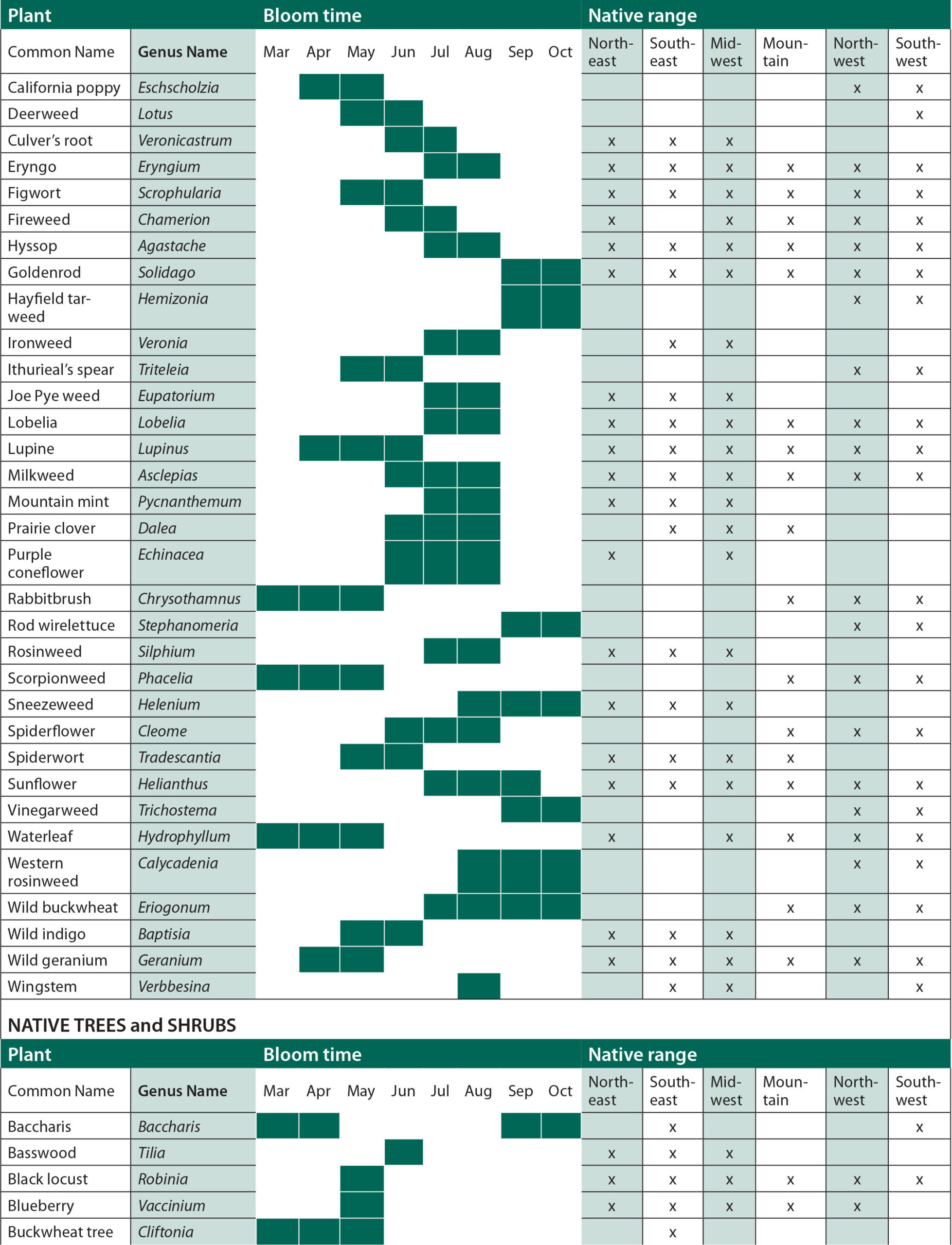


For more information on pollinator conservation, including in-depth resources on all of the topics mentioned above, see Pollinator Conservation Program.
Alternative Pollinators: Native Bees
By Eric Mader, Mace Vaughan, Matthew Shepherd, and Scott Hoffman Black of the Xerces Society for Invertebrate Conservation
Published 2010
©NCAT
IP126
Slot 25

